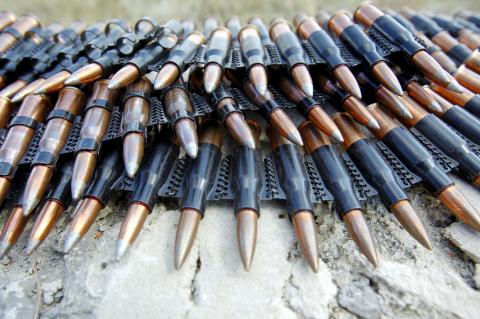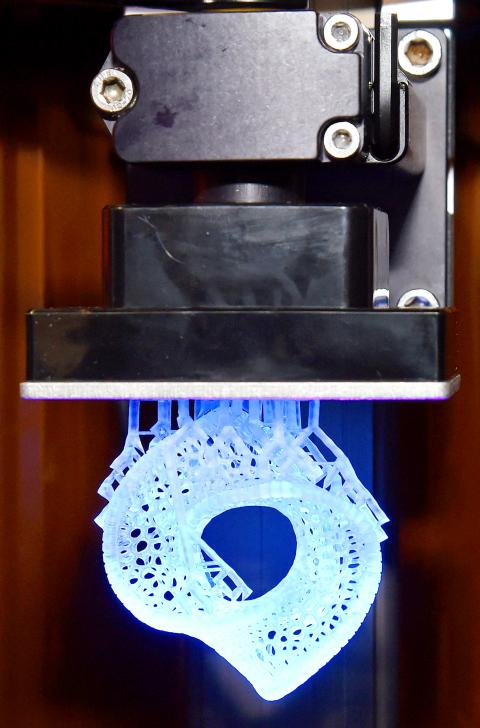3D printing will revolutionize war and foreign policy, say experts, not only by making possible incredible new designs but by turning the defense industry — and possibly the entire global economy — on its head.
For many, 3D printing still looks like a gimmick, used for printing useless plastic figurines and not much else. But with key patents running out this year, new printers that use metal, wood and fabric are set to become much more widely available — putting the engineering world on the cusp of major historical change. The billion-dollar defense industry is at the bleeding edge of this innovation, with the US military already investing heavily in efforts to print uniforms, synthetic skin to treat battlewounds, and even food, said Alex Chausovsky, an analyst at IHS Technology.
Scientists at the Massachusetts Institute of Technology have already invented “4D printing” — creating materials that change when they come into contact with elements such as water. One day, that could mean things like printed uniforms that change color depending on their environment.

In the real world, the baby steps are already being taken. Late last year, British defense firm BAE Systems put the first printed metal part in a Tornado jet fighter. The company recently put out an animated video showing where they think such humble beginnings could one day lead. It imagined a plane printing another plane inside itself and then launching it from its undercarriage. “It’s long term, but it’s certainly our end goal to manufacture an aerial vehicle in its entirety using 3D printing technology,” Matt Stevens, who heads BAE’s 3D printing division, told AFP.
REVOLUTIONIZING WAR AND POLITICS
But the real revolution of 3D printing is less about the things you can make and more about where you make them. Being able to take printers to a warzone promises a radical shake-up of combat and the defense industry, says Peter W Singer, an expert in future warfare at the New America Foundation.

Photo: AFP/Ethan Miller
“Defense contractors want to sell you an item but also want to own the supply chain for 50 years,” he says. “But now you’ll have soldiers in an austere outpost in somewhere like Afghanistan who can pull down the software for a spare part, tweak the design and print it out.”
This could lead militaries to cut out private defense companies altogether. And by combining 3D printing with assembly line robotics, those that remain will be enormously streamlined. That sort of disruption carries huge political implications in places like the US where defense firms are purposefully spread around the country and support millions of jobs. “The Pentagon and defense industry have an incredibly tough time with innovation, but you don’t want to wait to lose a major battle before you do it,” says Singer.
3D printing could even change foreign policy, for instance by undermining sanctions. “The US has sanctioned everything from fighter jet spare parts to oil equipment. 3D printing could turn sanctions — which have been a crucial part of foreign policy for a generation or more — into an antiquated notion,” says Singer.
Then there are the scarier prospects that come with reducing the barriers to arms manufacturing. “Think of master bombmakers in the Middle East making new designs that look like everyday products or a lone wolf operator printing a plastic gun he can get past security at the White House,” says Chausovsky.
But all of that may pale in comparison to the security risks that 3D printing could trigger by revolutionizing economies. If anyone can print retail goods, economies that rely on cheap factory labor to make things like clothes and toys may find themselves in deep trouble — with all the security consequences that go with that. “If you want to know where the big threat of 3D printing is, think about how reliant China is on its low-cost merchandising sector,” says Chausovsky.
‘CAN’T DRILL A CURVED HOLE’
3D printing — invented in the 1980s — is much older than many realize. The recent upsurge in interest is tied to the fact that patents on the original technology are expiring — opening the way for competition that will drive up quality and push down prices. The first major patents to run out were in 2009 for a system that used plastics known as “fused deposition modeling.” But the next big ones, that expired in the first half of 2014, are related to “selective laser syntering” that prints metals such as aluminum, copper and steel, and with much greater definition.
And rather than working with solid lumps of metal, engineers can create complex new shapes that use much less material without losing any strength.
“You can’t drill a curved hole,” says Chausovsky. “With 3D printing, you’re creating products that would never be possible with traditional methods.
The full implications are still hard to imagine. “It’s the first time in a very long time that there’s been such a radical shake up in industrial engineering,” says Stevens at BAE. “We’re not just improving things — we’re re-writing the rule book.”

Last week the story of the giant illegal crater dug in Kaohsiung’s Meinong District (美濃) emerged into the public consciousness. The site was used for sand and gravel extraction, and then filled with construction waste. Locals referred to it sardonically as the “Meinong Grand Canyon,” according to media reports, because it was 2 hectares in length and 10 meters deep. The land involved included both state-owned and local farm land. Local media said that the site had generated NT$300 million in profits, against fines of a few million and the loss of some excavators. OFFICIAL CORRUPTION? The site had been seized

Next week, candidates will officially register to run for chair of the Chinese Nationalist Party (KMT). By the end of Friday, we will know who has registered for the Oct. 18 election. The number of declared candidates has been fluctuating daily. Some candidates registering may be disqualified, so the final list may be in flux for weeks. The list of likely candidates ranges from deep blue to deeper blue to deepest blue, bordering on red (pro-Chinese Communist Party, CCP). Unless current Chairman Eric Chu (朱立倫) can be convinced to run for re-election, the party looks likely to shift towards more hardline

Sept. 15 to Sept. 21 A Bhutanese princess caught at Taoyuan Airport with 22 rhino horns — worth about NT$31 million today — might have been just another curious front-page story. But the Sept. 17, 1993 incident came at a sensitive moment. Taiwan, dubbed “Die-wan” by the British conservationist group Environmental Investigation Agency (EIA), was under international fire for being a major hub for rhino horn. Just 10 days earlier, US secretary of the interior Bruce Babbitt had recommended sanctions against Taiwan for its “failure to end its participation in rhinoceros horn trade.” Even though Taiwan had restricted imports since 1985 and enacted

Enter the Dragon 13 will bring Taiwan’s first taste of Dirty Boxing Sunday at Taipei Gymnasium, one highlight of a mixed-rules card blending new formats with traditional MMA. The undercard starts at 10:30am, with the main card beginning at 4pm. Tickets are NT$1,200. Dirty Boxing is a US-born ruleset popularized by fighters Mike Perry and Jon Jones as an alternative to boxing. The format has gained traction overseas, with its inaugural championship streamed free to millions on YouTube, Facebook and Instagram. Taiwan’s version allows punches and elbows with clinch striking, but bans kicks, knees and takedowns. The rules are stricter than the